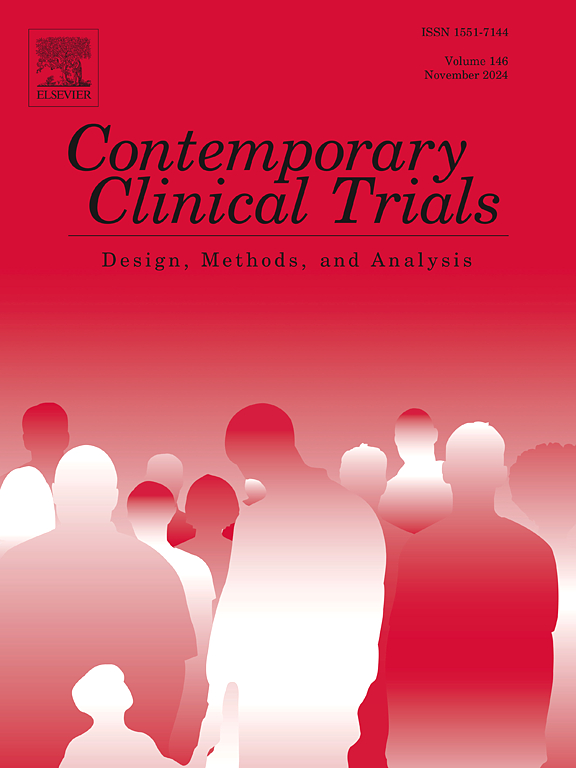用于临时样本量再估计的有希望区设计的实际考虑因素:应用 GRAPHITE 治疗移植物抗宿主疾病。
IF 2
3区 医学
Q3 MEDICINE, RESEARCH & EXPERIMENTAL
引用次数: 0
摘要
背景:样本量计算和功率估计是临床试验不可或缺的一部分。随着为满足未满足的医疗需求而加速开发,快节奏的开发可能会导致临床试验的初始规划和假设出现不确定性。有前景的区域设计为申办者提供了一个根据中期数据重新估计样本量的机会,以降低风险、减少不确定性并提高试验成功的概率:本文旨在以 GRAPHITE 试验(NCT03657160)为真实数据应用案例,从样本量调整规则、允许的最大样本量、多重性调整以及申办者对中期结果的访问等方面,展示在实施中期样本量重新估计(SSR)的前景区设计时的实际考虑因素。GRAPHITE是一项3期试验,使用维多珠单抗预防异基因造血干细胞移植(allo-HSCT)后的急性移植物抗宿主疾病(acute graft vs host disease,aGvHD)。主要疗效终点是异体造血干细胞移植后第+180天的较低肠无移植物抗宿主疾病存活率。我们进行了一项模拟研究,展示了在设计阶段通过各种真实的基本治疗效果对操作特性进行评估的方法:将有希望区设计应用于中期 SSR 是一项创新,它成功地帮助申办者实现了风险最小化与保持科学完整性之间的平衡。这项工作旨在强调经验指导的必要性,以便为临床研究人员在实践中获得更好的见解,并有望促进在 3 期试验中理解和实施中期 SSR 的有希望区设计。本文章由计算机程序翻译,如有差异,请以英文原文为准。
Practical considerations of promising zone design for interim sample size Re-estimation: An application to GRAPHITE for graft vs host disease
Background
Sample size calculation and power estimate are an integral part of clinical trials. With accelerated development to address the unmet medical needs, the fast-paced development may lead to uncertainties in initial planning and assumptions of clinical trials. Promising zone design presents sponsors an opportunity to re-estimate the sample size based on the interim data to mitigate risks, reduce uncertainties, and increase probability of trial success.
Methods
This paper aims to use the GRAPHITE trial (NCT03657160) as a real data application to showcase the practical considerations in implementation of promising zone design for interim sample size re-estimation (SSR), in light of sample size adaptation rules, maximum sample size allowed, multiplicity adjustment, and sponsor access to interim results. GRAPHITE is a phase 3 trial with vedolizumab for prophylaxis of acute graft vs host disease (aGvHD) after allogeneic hematopoietic stem cell transplant (allo-HSCT). The primary efficacy endpoint is lower intestinal aGVHD-free survival by Day +180 after allo-HSCT. A simulation study was conducted to demonstrate the evaluation of operating characteristics by various true underlying treatment effects at the design stage.
Conclusion
The application of promising zone design for interim SSR is novel and has successfully helped the sponsor achieve the balance between minimizing the risks and maintaining scientific integrity. This work aims to highlight the necessity of empirical guidance to gain better insights for clinical researchers in practice and is expected to facilitate the understanding and implementation of promising zone design for interim SSR in phase 3 trials.
求助全文
通过发布文献求助,成功后即可免费获取论文全文。
去求助
来源期刊
CiteScore
3.70
自引率
4.50%
发文量
281
审稿时长
44 days
期刊介绍:
Contemporary Clinical Trials is an international peer reviewed journal that publishes manuscripts pertaining to all aspects of clinical trials, including, but not limited to, design, conduct, analysis, regulation and ethics. Manuscripts submitted should appeal to a readership drawn from disciplines including medicine, biostatistics, epidemiology, computer science, management science, behavioural science, pharmaceutical science, and bioethics. Full-length papers and short communications not exceeding 1,500 words, as well as systemic reviews of clinical trials and methodologies will be published. Perspectives/commentaries on current issues and the impact of clinical trials on the practice of medicine and health policy are also welcome.

 求助内容:
求助内容: 应助结果提醒方式:
应助结果提醒方式:


